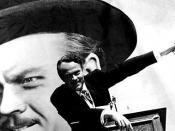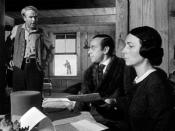The fresh, sophisticated, and classic masterpiece, Citizen Kane (1941), is probably the world's most famous and highly-rated film. Citizen Kane was the first movie Orson Welles, co-wrote, directed, and produced at only an age of twenty-five years. The subject of this movie is the life of Charles Foster Kane, known as Citizen Kane, which is played by Welles himself. Citizen Kane set a high standard for the art of cinematography as it made cinematic advances and technical innovations on many fronts. A new style of film making was created with innovations varying from the use of deep focus technique, camera positions and angles shots, storytelling and aural techniques.
The most innovative technical aspect of Citizen Kane is the extended use of deep focus technique which is considered to be the most significant contribution to cinematography. This technique allowed him to photograph backgrounds with as much clarity as foregrounds, as opposed to having only the people and things in the foreground in focus.
Such a technique is noticed in the scene where KaneÃÂs parents are filmed discussing his future while heÃÂs seen through the window in the foreground playing outside in the snow. Before Citizen Kane, the camera tended to film "context shots." The audience would be exposed to things that a human observer may not have noticed, but seemed natural on screen. Citizen Kane introduced a camera view that no human would see otherwise. It would notice two things at once, exemplified in the scene where Mr. Bernstein is discussing the influence of the new employees with Mr. Leland, and Mr. Kane can be seen in the mirror reflection dancing with the showgirls.
Moreover, another unconventional method used in the film was the low-angle shot. This technique tends to elongate a person or object, making him or...


